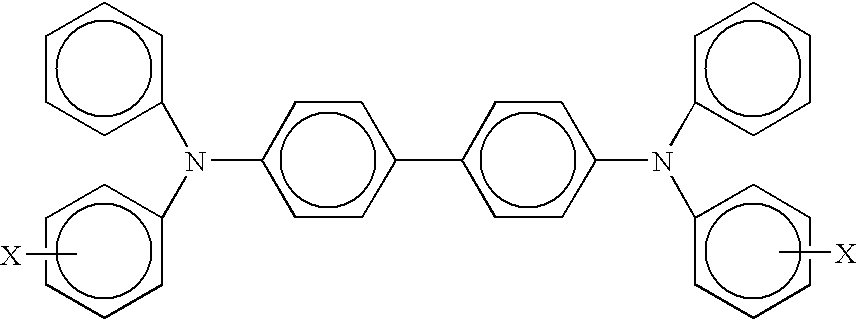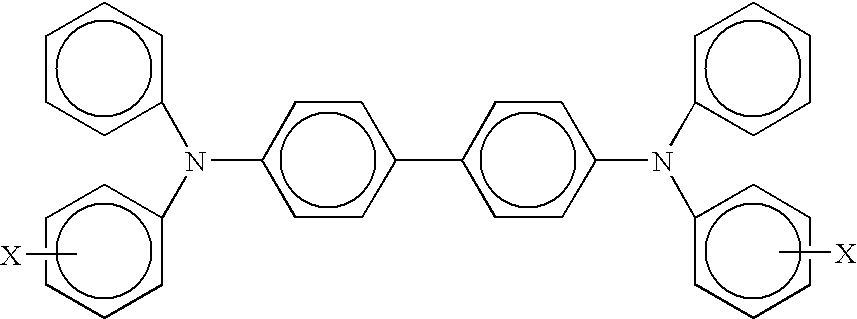Dual charge transport layer and photoconductive imaging member including the same
a charge transport layer and photoconductive imaging technology, applied in the direction of instruments, electrographic process apparatus, corona discharge, etc., can solve the problems of poor charge acceptance and cyclic instability, photoreceptor degradation, and charge transport molecules are frequently exposed to deleterious environmental conditions
- Summary
- Abstract
- Description
- Claims
- Application Information
AI Technical Summary
Benefits of technology
Problems solved by technology
Method used
Image
Examples
example 1
[0081]An imaging member was prepared by providing a 0.02 micrometer thick titanium layer coated on a biaxially oriented polyethylene naphthalate substrate (KALEDEX™ 2000) having a thickness of 3.5 mils, and applying thereon, with a gravure applicator, a solution containing 50 grams 3-amino-propyltriethoxysilane, 41.2 grams water, 15 grams acetic acid, 684.8 grams of 200 proof denatured alcohol and 200 grams heptane. This layer was then dried for about 5 minutes at 135° C. in the forced air drier of the coater. The resulting blocking layer (14) had a dry thickness of 500 Angstroms.
[0082]An adhesive layer (16) was then prepared by applying a wet coating over the blocking layer, using a gravure applicator, containing 0.2 percent by weight based on the total weight of the solution of copolyester adhesive (Ardel D100 available from Toyota Hsutsu Inc.) in a 60:30:10 volume ratio mixture of tetrahydrofuran / monochlorobenzene / methylene chloride. The adhesive layer was then dried for about 5 ...
example 2
[0088]An imaging member was prepared as in Example 1 except each of the top and bottom layers of the charge transport layer contained 6.8% Irganox 1010® by weight of the dry solids. The weight ratio of 1:1 N,N′-diphenyl-N,N′-bis(3-methylphenyl)-1,1′-biphenyl-4,4′-diamine and Makrolon 5705® remained the same.
example 3
[0089]An imaging member was prepared as in Example 1 except the top layer of the charge transport layer contained 6.8% Irganox I-1010® by weight of the dry solids. The weight ratio of 1:1 N,N′-diphenyl-N,N′-bis(3-methylphenyl)-1,1′-biphenyl-4,4′-diamine and Makrolon 5705® remained the same.
PUM
 Login to View More
Login to View More Abstract
Description
Claims
Application Information
 Login to View More
Login to View More - R&D
- Intellectual Property
- Life Sciences
- Materials
- Tech Scout
- Unparalleled Data Quality
- Higher Quality Content
- 60% Fewer Hallucinations
Browse by: Latest US Patents, China's latest patents, Technical Efficacy Thesaurus, Application Domain, Technology Topic, Popular Technical Reports.
© 2025 PatSnap. All rights reserved.Legal|Privacy policy|Modern Slavery Act Transparency Statement|Sitemap|About US| Contact US: help@patsnap.com



